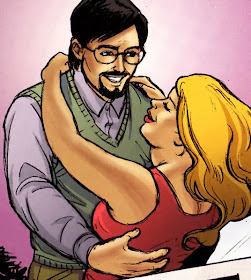Conclusion
Having spent the last month reading and blogging about Hack/Slash, I thought I should finish by going back to the beginning. As a life-long fan of the horror genre, I’ve often wondered how best to handle these stories within the guidelines of library work. In school (Kindergarten through grade 12) horror stories are often limited due to graphic content, and as good horror “…allows the reader to feel the action and fear with all their five senses, and [comic books] use of illustration to help tell [the] story adds a new element to the appeal” (Spratford, 2012, p. 133) it is even easier to quickly pass judgment on a title and consider it inappropriate for young readers.
My first interaction with horror fiction, and not just YA fiction with scary bits in, was back in Junior High (middle school for my American readers) when I was sitting in the school library reading fantasy fiction and noticed another teen return a book called The Shining to the librarian, who immediately slipped it behind her desk. Gathering up the courage to talk to her, I was informed that although the school had a small collection of Horror novels, they were kept behind the library desk to ensure that they didn’t alarm uninterested students. Of course, finding out that my library had a secret library collection, and that it was deemed too dangerous for the average student, had me interested in seconds, and within a few months horror was the genre for me. Over the next few years I became a fan of the stories, plays, games and films of the genre, and yes, that included the Slasher film.
Looking at the mechanics of Hack/Slash, I loved the crossovers, involving Cassie and Vlad with characters from film, fiction and both print and web comics in a way that made sense and probably introduced a lot of new readers/viewers to the crossed over material. The series played with horror movie concepts ranging from horror movie logic, sequels, and trailers, and then moved on to questions of how a horror movie-themed world would really work and what regular people could and would do in incredibly tense situations.
What I love most about Hack/Slash is the honest love it has for the genre, and specifically the slasher sub-genre. Considering that slasher movies are often considered to be bottom-of-the-barrel films, this series treats its source material with great care, pointing out some errors yes, but working the whole way to increase the emotional connection the reader will have with Cassie, Vlad, and every other human character it introduces, and getting the reader to care about what happens to these characters, and in the end, what else do you want from any story?
IMAGE USED
McDevitt, M. (2013) Bookmonkey vs Hack/Slash [Image]. Retrieved from http://wisdomofbookmonkey.blogspot.ca/2013/10/bookmonkey-vs-hackslash-day-thirty.html
WORKS CITED
Spratford, B. (2012). The Readers’ Advisory Guide to Horror. Chicago, American Library Assocation.











